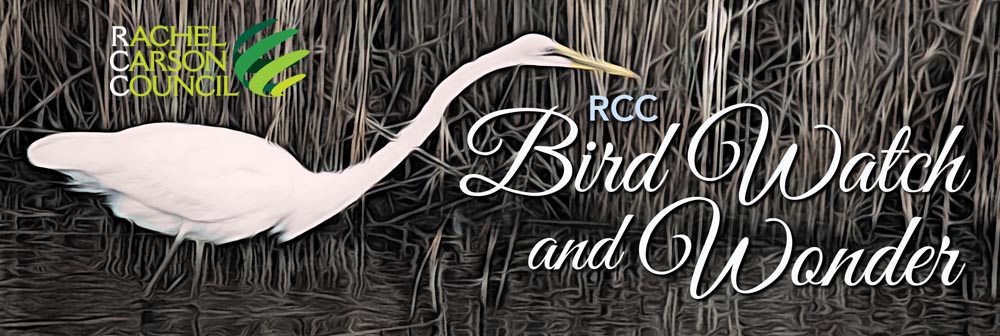 | | | After a cool, wet early spring in the Northeast, April has burst into glorious birdsong, nesting and dazzling displays of color on birds and bushes alike. As Florence Williams has documented with scientific data in The Nature Fix, just being outside in nature, or hearing birds sing, lifts our spirits, even makes us more giving and forgiving human beings. That’s why our April issue of RCC’s Bird Watch and Wonder (it is Earth Month after all) zooms in on the joys of being at one with the birds and, if only for a time, forgetting the cortisol, hypertension producing downer of still following the trials of Donald Trump. 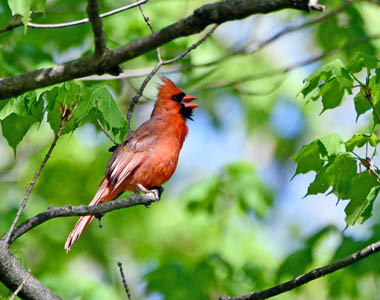 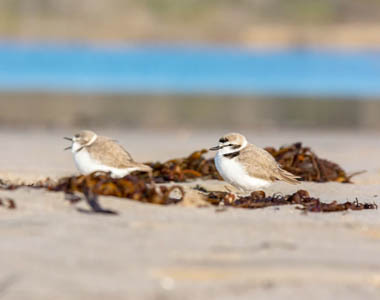 As what Rachel Carson called the “dawn chorus” awakens you, aside from pulling a pillow over your head, you may wonder why birds make such a racket and so early in the morning. You’ll find the answers at the top of our issue. And, as the weather warms, many of us will be heading to coastal beaches where we may come upon the wonders of shore bird favorites like the Snowy Plover, Piping Plover, or Black Skimmer, and even familiar species like the Herring Gull, sitting atop their eggs. That’s why Bethany Carl Kraft urges us to share the shore, rein in the kids and dogs and our own impulse to just get really close to such amazing, soul stirring sights. As what Rachel Carson called the “dawn chorus” awakens you, aside from pulling a pillow over your head, you may wonder why birds make such a racket and so early in the morning. You’ll find the answers at the top of our issue. And, as the weather warms, many of us will be heading to coastal beaches where we may come upon the wonders of shore bird favorites like the Snowy Plover, Piping Plover, or Black Skimmer, and even familiar species like the Herring Gull, sitting atop their eggs. That’s why Bethany Carl Kraft urges us to share the shore, rein in the kids and dogs and our own impulse to just get really close to such amazing, soul stirring sights. 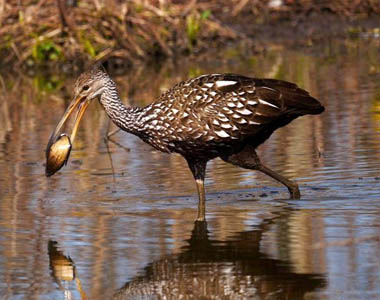 We know, too, the dangerous effects of global climate change for birds and their habitat, but even amidst the changing weather, there are heart-warming stories and sights to be found. In Louisiana, plagued by invasive apple snails, the ungainly Limpkin, with its eerie, loud, screeching calls, has moved into town like a Western marshal to clean up the offending snails. We know, too, the dangerous effects of global climate change for birds and their habitat, but even amidst the changing weather, there are heart-warming stories and sights to be found. In Louisiana, plagued by invasive apple snails, the ungainly Limpkin, with its eerie, loud, screeching calls, has moved into town like a Western marshal to clean up the offending snails.
And, if you delight in the spring song of the Song Sparrow (“Hip-hip-hooray-boys, spring is here again!”), you will be thrilled to learn that scientists have measured adaptations to climate change in our chorister, with warmer climes producing slightly smaller birds and cooler climates larger ones better suited to fend off the cold. Since Florence Williams notes that even looking at pictures of nature and birds can make us feel better, we have gathered a bevy of bird art for you like Jake Messing’s “Azure Guard,” a water color inspired by the mobbing behavior of Blue Jays, and the stylized letterpress prints of Roy Scholten that use Legos bricks to form his birds. All of the burgeoning bird life that makes April such a beautiful, sensuous season also gives rise to what Rachel Carson called “a sense of wonder.” We are in awe at these creatures with whom we share a garden, a woodland, a beach, or even a distant island, a speck amidst the endless sea. This month, in “Bird Lore,” RCC’s Ross Feldner takes us to far off Midway Island National Wildlife Refuge to meet Wisdom, an incredible 72-year old Laysan Albatross first banded in the 1950s by renowned ornithologist and government scientist, Chan Robbins, a close friend and colleague of Rachel Carson. So, if you are feeling tired or blue, consider Wisdom. She has flown over 300,000 miles in her lifetime, survived a killer tsunami, and produced some 36 offspring, including every year since 2006. | | | | | | | | 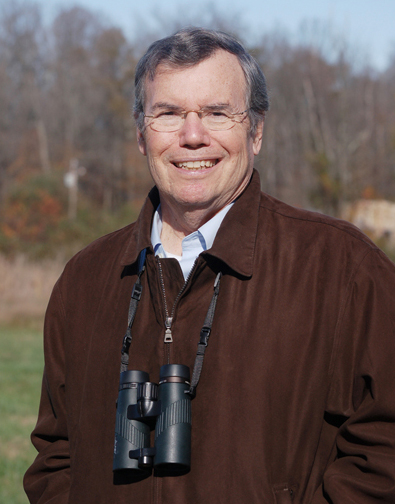 Bob Musil is the President & CEO of the Rachel Carson Council and author of Rachel Carson and Her Sisters: Extraordinary Women Who Have Shaped America’s Environment (Rutgers, 2016) and Washington in Spring: A Nature Journal for a Changing Capital (Bartleby, 2016). He is also the editor of the forthcoming annotated edition from Rutgers University Press of Rachel Carson’s Under the Sea-Wind with his Introduction, updated marine science, and historic and contemporary illustrations and photographs. Bob Musil is the President & CEO of the Rachel Carson Council and author of Rachel Carson and Her Sisters: Extraordinary Women Who Have Shaped America’s Environment (Rutgers, 2016) and Washington in Spring: A Nature Journal for a Changing Capital (Bartleby, 2016). He is also the editor of the forthcoming annotated edition from Rutgers University Press of Rachel Carson’s Under the Sea-Wind with his Introduction, updated marine science, and historic and contemporary illustrations and photographs. | | | | | | Nature Curiosity: Why Do Birds Sing in the Morning? If you've ever buried your head under a pillow to drown out the sounds of birds loudly singing their familiar songs before the crack of dawn, you're probably not alone. Birds have a way of making their presence known even before the sun rises each day, and in the spring especially they can create quite a racket. The birds aren't just greeting the new day with a cheerful good morning, and it doesn't have anything to do with the early bird getting the worm, either. | | | | | | | | Injury or Illusion? Why a Bird With a Broken Wing May Not Be What It Appears Some species feign injuries to protect their nests from predators—a more common behavior than previously thought, new research shows. Ornithologist Clinton Francis was leading a class field trip along the California coast when students spotted what appeared to be an injured Killdeer. They watched as the striking shorebird aggressively called and held out a contorted wing. | | | | | | | | Poisoning by Rodenticide Played a Part in Flaco the Owl's Death The Much-Loved Owl Had Debilitating Levels of Rodenticide in His System. A necropsy on the body of Flaco, the famous Eurasian Eagle-Owl that captivated New Yorkers, has revealed a grim and sobering reminder of the impacts of pesticides on wildlife. While traumatic injuries from a window collision — an all-too-common occurrence that kills hundreds of millions of birds each year — ultimately caused Flaco's death, the well-loved owl was also found to be carrying lethal levels of rodenticide. | | | | | | | | Bergmann’s Rule May Hint at Adaptability of Song Sparrows North American Song Sparrows may have some resilience to climate change built into their genes, thanks to a remarkable adaptation that accounts for the stunning range of body sizes found throughout the bird’s westernmost range. That adaptation was the focus of a study, published November 7 in the journal Nature Communications, that offers support for Bergmann’s Rule—a pattern in zoology. | | | | | | | | It’s Nesting Season: Don’t Forget to Share the Shore with Coastal Birds Birds like plovers and terns need our help to safely raise their chicks on beaches this summer. As the weather warms up, many of us will be visiting the beach this summer. We’re not the only ones who love the sun and sand—tiny, cotton-ball-sized chicks like Western Snowy Plovers will soon be hatching and running around on those same beaches. They’re well camouflaged and easy to miss, so they need our help to make sure they can grow up safely, even while we’re nearby enjoying the beach with our families and pets. | | | | | | | | On Kaho’olawe, New Technology Could Restore a Sacred Hawaiian Island To bring seabirds back to Kaho‘olawe, you need to first find the cats. And to find the cats on Kaho‘olawe, you need to know where to find the bombs. Eleven kilometers, about 7 miles, off the coast of Maui, the island of Kaho‘olawe — the smallest of the main Hawaiian Islands — presents conservationists with a unique opportunity. Small, remote, and sparsely inhabited by humans, it’s almost a perfect location to restore populations of the native seabirds that have been otherwise devastated across Hawai‘i. The one problem? Cats. | | | | | | | | | | The U.S. Keeps Making Promises to Oil Companies. The Birds of Teshekpuk Lake Need Promises, Too. In the nearly continuous daylight of Alaskan summer, millions of breeding shorebirds cram into the wetlands of Teshekpuk Lake, arctic Alaska's largest lake. The spectacle exceeds the Arctic National Wildlife Refuge in terms of importance to migratory waterbirds. Almost 30 years ago, as an aspiring 25-year-old wildlife photographer, I took my camera north along Alaska’s Dalton Highway to catch my first glimpse of muskox, Arctic tundra, and the region’s bountiful birdlife. | | | | | | | | Most Bird Species Cannot Tolerate Man-Made Environments A new study finds that 78% of the world’s bird species do not thrive in the most modified human-dominated environments. Currently 14% of the world’s 11,000 bird species are threatened with extinction. The new study assessed the populations of bird species across a spectrum of landscapes from pristine habitats to human-dominated environments. | | | | | | | | This New-to-Louisiana Bird Wails Like a Banshee But Eats Pesky Nuisance, Saving Crops Screechy, gangly bird gorges on invasive apple snails, helping wetlands and crawfish farms. It's not a colorful or elegant bird, nor does it sing anything that could be described as pleasant. Its feathers are drab. Its beak droopy, and its long-legged gait is so gimpy that it was cursed with one of the most disparaging names in all of birddom: the Limpkin. | | | | | | | | In Maine's North Woods, Some Bird Species Are Increasingly Abundant. Scientists Aren't Sure Why Amid the bleak reports about a precipitous loss in numbers and types of birds around North America and the rest of the world is a glimmer of hope in Maine's North Woods. A new study has found something unexpected and scientists aren't yet sure how to explain it. More than three decades ago, a team of researchers undertook a project near Moosehead Lake to document how songbirds were being affected by commercial forest practices including clearcutting. | | | | | | | | ‘Simply Mind-boggling’: World Record Temperature Jump in Antarctic Raises Fears of Catastrophe An unprecedented leap of 38.5C in the coldest place on Earth is a harbinger of a disaster for humans and the local ecosystem. On 18 March, 2022, scientists at the Concordia research station on the east Antarctic plateau documented a remarkable event. They recorded the largest jump in temperature ever measured at a meteorological centre on Earth. According to their instruments, the region that day experienced a rise of 38.5C above its seasonal average: a world record. | | | | | | | | No Birdsong, No Water in the Creek, No Beating Wings: How a Haven For Nature Fell Silent As the soundscape of the natural world began to disappear over 30 years, one man was listening and recording it all The tale starts 30 years ago, when Bernie Krause made his first audio clip in Sugarloaf Ridge state park, 20 minutes’ drive from his house near San Francisco. He chose a spot near an old bigleaf maple. Many people loved this place: there was a creek and a scattering of picnic benches nearby. | | | | | | | | Wisdom, the World’s Oldest Wild Bird The late, great comedian Richard Pryor used to say, “you don’t get old be’in no fool” and boy this bird sure ain’t no fool! Wisdom is a wild female Laysan albatross, the oldest confirmed wild bird in the world and the oldest banded bird in the world who was first tagged in the 1950s at Midway by the United States Geological Survey (USGS). World renowned ornithologist Chandler Robbins attached the first tag on her when he was a senior scientist at the United State Geological Service (USGS). | | | | | | | | Birdword: An Illustrated Guide to Some Tongue-Twisting Ornithological Terms They’re sometimes called technical terms, eight-dollar-words, jargon, or just plain gobbledygook. But hidden inside those multisyllabic ornithological utterances are keys to fascinating behaviors, time machines to take you back to ancient Greek and Latin, and sly insights to the minds of scientists at work. In this recurring feature by illustrator Rosemary Mosco we break down a few of the “birdwords” we enjoy the most. | | | | | | | | The Eclipse Within Our Grasp Find yours among the coronas burning here on Earth The heavens hold no exclusivity on an eclipse. A corona circles the eye of a tropical bird. It burns on the wing of a butterfly. It even glows on a rodent. For those of you who won’t get to see the total solar eclipse on Monday, I bring you earthly coronas instead, each a ring of fire, a totality of the wild. | | | | | | | | Gallery: An Azure Guard of Blue Jays Artist Jake Messing creates lush, collage-like works that are a modern take on colorful, Baroque-era still lifes. He draws inspiration from the life-and-death cycles of nature, and the interesting or unusual behaviors he’s observed while exploring the outdoors, such as shrikes impaling their prey and cardinals attacking car mirrors. For his watercolor Azure Guard, he was inspired by an observation of mobbing behavior during a late-summer trip to the Catskill Mountains in Upstate New York. | | | | | | | | Birds Through a Camera’s Lens by David Collins The Yadkin Arts Council will present “Birds Through a Camera’s Lens” May 2 – June 21, 2024 in the Welborn Gallery at the Yadkin Cultural Arts Center. An opening reception will be held on Thursday, May 2nd from 5-7pm in the Welborn Gallery to celebrate this exhibit. Refreshments will be served. Admission is Free and all are welcome to attend. | | | | | | | | An Artist Used Lego to Make These Stunning Bird Prints Artist Roy Scholten developed a technique that uses Lego bricks for his letterpress prints. When Dutch artist Roy Scholten sets out to make a new print, his first order of business is sorting through tubs of Lego blocks. That’s because Scholten’s latest collection of work, titled 50 Birds, depicts birds native to the Netherlands—feathers, beaks, legs, and all—using only Legos as a printing tool. | | | | | | | | | | | | Cinnamon Teal The male of this dabbling duck species lives up to its name with rich cinnamon coloring. It also displays an eye-catching blue wing patch. The female has more subdued brown markings. The Cinnamon Teal is found in central and western America near freshwater marshes, ponds, flooded fields and small streams. Like Killdeer and other birds if danger threatens the female will put on the broken-wing act to distract the predator. | | | | | | | | Momentary Meditations are published every Monday to awaken what Rachel Carson called “the sense of wonder” and what Albert Schweitzer called “a reverence for life.” Looking deeply into our interdependence with all life on earth helps us know what we must do. In our harried world, these meditations are meant to serve as a renewable resource for compassion and love. A Yellow Presence - My attention was on three blue heron couples renovating their homes in a gangly dead tree. Then a rustling and a yellow flash drew my attention to a shoreline shrub. There, almost within reach, a group of tiny Palm Warblers gathered. I was reminded of how hard it is to see what is taking place nearby in plain sight. | | | | | | | | Birding to Change the World
A Memoir By Trish O'Kane 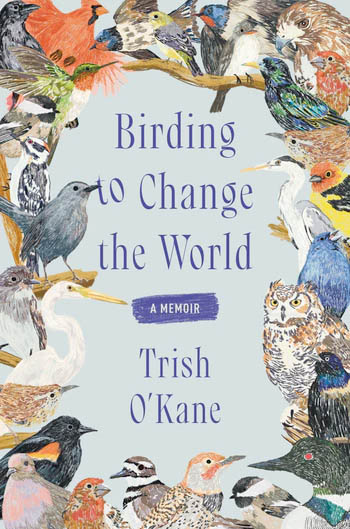 In this uplifting memoir, a professor and activist shares what birds can teach us about life, social change, and protecting the environment. In this uplifting memoir, a professor and activist shares what birds can teach us about life, social change, and protecting the environment.
Trish O’Kane is an accidental ornithologist. In her nearly two decades writing about justice as an investigative journalist, she'd never paid attention to nature. But then Hurricane Katrina destroyed her New Orleans home, sending her into an emotional tailspin.Enter a scrappy cast of feathered characters—first a cardinal, urban parrots, and sparrows, then a catbird, owls, a bittern, and a woodcock—that cheered her up and showed her a new path. Inspired, O'Kane moved to Madison, Wisconsin, to pursue an environmental studies PhD. There she became a full-on bird obsessive—logging hours in a stunningly biodiverse urban park, filling field notebooks with bird doings and dramas, and teaching ornithology to college students and middle-school kids. When Warner Park—her daily birdwatching haven—was threatened with development, O’Kane and her neighbors mustered a mighty murmuration of nature lovers, young and old, to save the birds' homes. Through their efforts, she learned that once you get outside and look around, you're likely to fall in love with a furred or feathered creature—and find a flock of your own. In Birding to Change the World, O'Kane details the astonishing science of bird life, from migration and parenting to the territorial defense strategies that influenced her own activism. A warm and compelling weave of science and social engagement, this is the story of an improbably band of bird lovers who saved their park. And it is a blueprint for muscular citizenship, powered by joy. Click here to purchase | | | | | | Birding Festivals and Events A great way to enjoy bird watching is by going to festivals—they’re organized to get you to great birding spots at a great time of year, and they’re a great way to meet people. Experts and locals help you see more birds, and you’ll meet other visitors who share your hobby. While you’re there, keep an eye out for Cornell Lab representatives, as we do attend several festivals each year. | | | | | | | | The April 2024 issue of Bird Watch and Wonder was produced by Ross Feldner | | | | | |  The Rachel Carson Council Depends on Tax-deductible Gifts From Concerned Individuals Like You. Please Help If You can. The Rachel Carson Council Depends on Tax-deductible Gifts From Concerned Individuals Like You. Please Help If You can. | | | |  Sign Up Here to Receive the RCC E-News and Other RCC Newsletters, Information and Alerts. Sign Up Here to Receive the RCC E-News and Other RCC Newsletters, Information and Alerts. | | | | | | | | | | | |